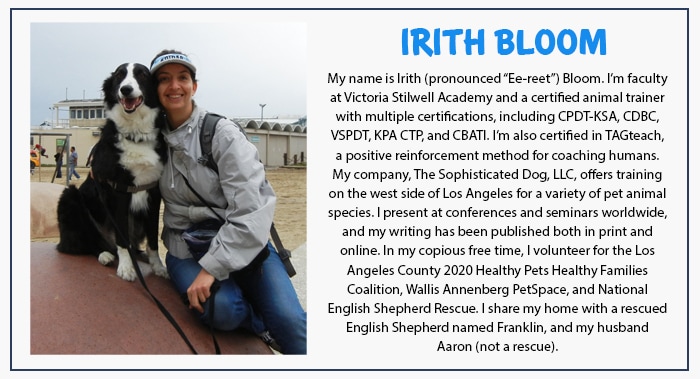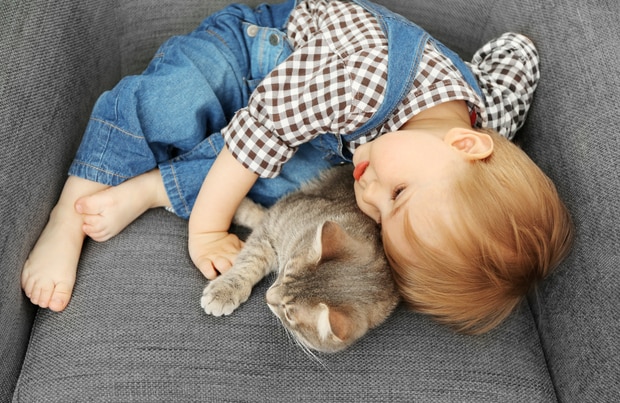Contributed by Irith Bloom, faculty at Victoria Stilwell Academy and certified animal trainer with multiple certifications, including CPDT-KSA, CDBC, VSPDT, KPA CTP, and CBATI.
Kids and pets don’t always get along. In fact, the majority of dog bites happen to children under the age of 10. This isn’t really that surprising when you think about it. Both young children and dogs don’t always think carefully before they act. Children can accidentally cause pain to their pets, and pets sometimes scratch or bite in a panic. Parents and guardians of kids and pets need to be proactive to keep everyone safe.
I was lucky growing up. My first dog was an extremely gentle Rottweiler who bonded to me the day he came to our home. My parents had also spent my entire childhood up to that point teaching me how to treat animals appropriately, so I knew how to behave around him right away, which probably facilitated that bonding process. My parents also supervised our interactions, to make sure I was always kind and mindful of the dog’s needs. I went on walks with my parents and the dog daily and attended all his training classes. My parents always made it clear to me that having a dog was a privilege, and that treating dogs with respect was essential.
Unfortunately, not all adults teach their children how to behave around animals, and many have no idea how to deal with kids and pets. In fact, when I am at the home of a client who has both children and pets, I often find myself having to intervene to make sure the child and dog stay safe.
While some types and breeds of pets tend to be calmer around children, every animal is an individual. No pet is guaranteed to be safe around children. When someone tells you a certain breed is “the best family dog,” take that advice with a grain of salt. Any dog will bite if pushed hard enough, and there is no such thing as a pet that is safe for kids. I know Golden Retrievers who have bitten, while my Rottweiler never even growled or bared his teeth at me or any of my friends.
Interactions between kids and pets can get out of hand. Children may not be old enough to understand that a pet has feelings. They may poke the pet’s eyes, pull on its tail, stick objects in its ear, and so on. I am sometimes astonished at the behavior I see parents allow to happen since it’s so obviously uncomfortable for the pet. It’s understandable that pets occasionally lash out when a child does something invasive or painful to the pet—and it’s not the pet’s fault or the child’s fault. In the end, the responsibility has to rest with the mature adults in the area.
The first step in keeping kids and pets safe is for the adults in the household to learn to read the animal’s body language. When I walk into a client home where there are both children and animals, this is usually the first thing we talk about. Animals have body language signals they use when they are feeling stressed, frightened or overwhelmed. Unfortunately, we are not always tuned into these signals, so we wind up ignoring them.
Subtle signs of stress in dogs include trying to hide or walk away, turning the head away, repeated lip licking, lifting one paw, whale eye (where you can see the whites of the dog’s eye), yawning, sudden scratching, abruptly starting to sniff the ground or some other object, shaking off even though the dog is not wet, rapid panting, tail low or tucked between legs, and ears back or sideways. In cats, signs of stress include crouching with tense muscles and tail or feet kept close to, or even tucked under, the body. Stressed cats also often have round pupils that are larger than normal, and their ears tilt to the sides or are pinned back. An arched back is a fairly obvious sign the cat is stressed, as are growling and hissing, of course.
When a pet feels that their whispered requests for space are not being heard, they will ask in a louder manner. The goal of learning the animal’s subtle body language signals is to spot the signs of stress early, before there is growling, hissing, scratching or biting.
Learning about your pet’s body language is the first step in keeping your kids and pets safe. Some books that will help you become familiar with your pet’s communication style include Understanding Your Dog For Dummies, which covers a wide range of topics and even has questionnaires you can use to get a clearer picture of your own dog, and Victoria Stilwell’s The Secret Language of Dogs: Unlocking the Canine Mind for a Happier Pet, which covers everything from canine perception to cognition and communication.
To learn more about the stress signals of other animals (such as birds), check for online resources on the body language of those species. Since anyone—even if they have no education or background—can use the term “behaviorist,” make sure to look for resources created by people with legitimate certifications. Information from Certified Applied Animal Behaviorists (CAAB) and Diplomates of the American College of Veterinary Behaviorists (DACVB) is particularly reliable.
There are also resources designed for people with kids and pets, such as doggonesafe.com, dogsandbabieslearning.com, and familypaws.com. For information on body language in dogs, you can also look up “Turid Rugaas Calming Signals” or “Ladder of Aggression.” These resources will help you learn how to spot stress and anxiety in your pet early, so you can interrupt and redirect before things get out of hand.
Once you understand your pet’s body language better, you will be ready to start helping your pet and child live together in harmony. As I mentioned earlier, there is no such thing as a reliably kid-friendly pet. All animals have feelings, can be hurt and can potentially injure your child. The key to keeping kids and pets safe and happy is appropriate management and active supervision.

Share:













